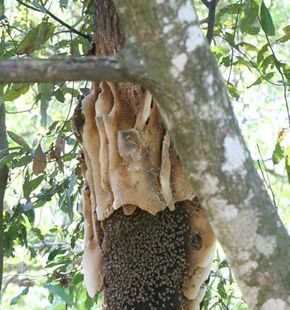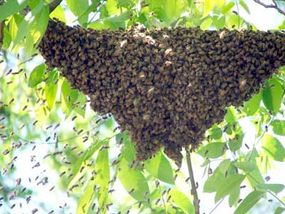Quck answer
Bees are social insects that live in colonies. They have a complex social structure and are divided into different castes, including the queen, workers, and drones. Bees collect nectar from flowers and turn it into honey, which serves as their food source. They also play a crucial role in pollinating plants, which helps to produce fruits and vegetables. Bees communicate with each other through a dance-like movement that indicates the location of food sources. Unfortunately, bees are facing numerous threats, including habitat loss, pesticides, and diseases, which have caused significant declines in their populations worldwide.
Wild Animals
Different Varieties of Bees

An unmanaged honeybee colony in the wild
Image courtesy MadMaven/T.S.Heisele/ Stock.xchng
Scientifically speaking, bees belong to the insect superfamily Apoidea, which comprises around 20,000 species of bees, divided into various families, subfamilies, and tribes. The bees within each family share a few common traits, such as nest-building methods, but different species usually possess unique physical characteristics like tongue length or wing shape.
Most people are familiar with honeybees and bumblebees, both of which are social bees that live in large groups. Social bees use their body’s wax secretions to build big nests and containers to store food and raise their young. A third type of social bee is the stingless bee, which is native to tropical regions and is used for honey production in some societies. Until recently, stingless beekeeping was common in the Mayan areas of South America, but this practice has almost disappeared in the last two decades.
Although honeybees and bumblebees are both social, their societies are vastly different. Honeybee colonies, or hives, are perennial, and a queen and her daughters build a nest using wax from their wax glands, which can last for generations. If the hive becomes overcrowded, the workers, all female, will raise a new queen by feeding her royal jelly from a gland on their heads. The old queen will leave the hive with about half of the workers to build a new nest, and the new queen will stay behind. The bees know it’s time to raise a new queen when they stop receiving enough queen substance, which is a pheromone the queen produces in her mandibular glands.

When honeybees leave a hive to start a new nest, they form a swarm.
Image courtesy MorgueFile
On the other hand, bumblebees have annual nests. Every year, the queen mates in the fall, spends the winter underground, and builds a nest in the spring where she lays eggs. When her daughters hatch, they become workers, helping the queen enlarge the nest. At the end of summer, the queen lays eggs that hatch into new queens and male drones. The drones gather at a mating site to mate with queens from various colonies, and the cycle continues.
Most people are familiar with social bees because they are more visible than solitary bees. Many social species produce substances that people use, like honey and beeswax, and people can see large groups of social bees feeding in orchards and gardens. But most bees are solitary, and less than 15% of them live in colonies. They may exhibit some social tendencies, but they don’t build large hives or store lots of extra honey. Instead, they build small nests that are big enough to hold a few eggs or a single egg. Sometimes, many solitary bees build their nests close together, but with the exception of mating and the occasional group defense of the nest site, these bees usually do not interact with each other.
Some species of bees use different materials to make their nests. Solitary bees use cerumen, propolis, and other materials to line their nests. Carpenter bees bore holes in unpainted wood, while plasterer bees dig holes and cover them with a plaster-like secretion. Leafcutter bees use their mouth parts to cut pieces of leaves, and mason bees use their saliva to glue sand and pebbles together. Carder bees collect the woolly parts of plants to line their nests. Some bees use existing materials like empty termite hills or wasp nests. Some lay their eggs in empty snail shells, while cuckoo bees lay their eggs in other bees’ nests. Other solitary bees are attracted to different types of flowers, and orchid bees have a long proboscis that they use to reach nectar deep inside orchid flowers. Africanized honeybees are a hybrid of African and European honeybees that are more aggressive when defending their nests.
FAQ
1. What is a bee?
A bee is a type of insect that is known for its important role in pollinating plants and producing honey.
2. How do bees communicate with each other?
Bees communicate with each other through a combination of pheromones, body language, and sound. They use their sense of smell to recognize each other and to locate food sources.
3. How do bees make honey?
Bees make honey by collecting nectar from flowers and storing it in their honey stomachs. They then regurgitate the nectar into the cells of the hive, where it is further processed by other bees and eventually becomes honey.
4. Why are bees important to the environment?
Bees are important to the environment because they play a crucial role in pollinating plants. Without bees, many plants would not be able to reproduce and the food chain would be disrupted.
5. How many different types of bees are there?
There are over 20,000 different species of bees in the world. The most well-known species is the honey bee, but there are also many other types of bees, including bumblebees, sweat bees, and carpenter bees.
6. How do bees navigate?
Bees navigate using a combination of the sun, landmarks, and their sense of smell. They are able to communicate the location of food to other bees through a dance known as the waggle dance.
7. How long do bees live?
The lifespan of a bee depends on its role in the hive. Worker bees typically live for a few weeks to a few months, while queen bees can live for several years.
8. How do bees defend themselves?
Bees defend themselves by stinging intruders. When a bee stings, it releases a venom that can be painful and even deadly to some people.
9. How do bees hibernate?
Bees do not hibernate like some other animals. Instead, they cluster together in the hive to keep warm during the winter months.
10. How do bees help the economy?
Bees help the economy by pollinating crops and producing honey, which can be sold for profit.
11. How can we help bees?
We can help bees by planting bee-friendly flowers and avoiding the use of pesticides and other harmful chemicals in our gardens.
12. Are bees threatened by extinction?
Yes, many bee species are threatened by extinction due to habitat loss, pesticide use, and other factors. This is a serious concern because of the important role that bees play in our ecosystem.





Leave a Reply